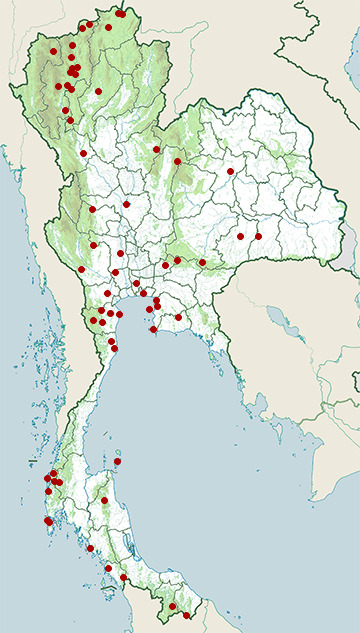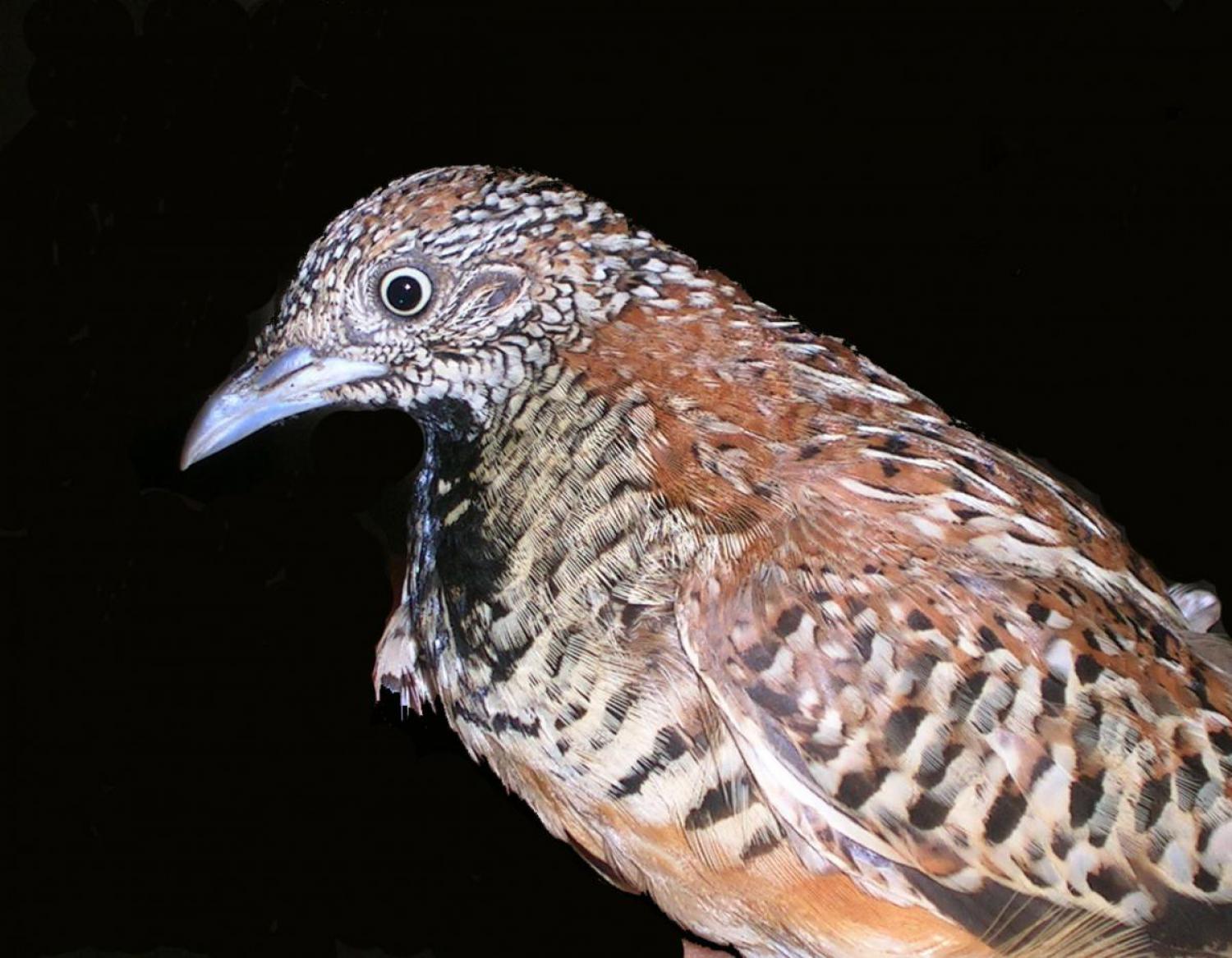Species of Thailand
Barred buttonquail
Turnix suscitator
Johann Friedrich Gmelin, 1789
In Thai: นกคุ่มอกลาย
The barred buttonquail or common bustard-quail (Turnix suscitator) is a buttonquail, one of a small family of birds which resemble, but are unrelated to, the true quails. This species is resident from India across tropical Asia to south China, Indonesia and the Philippines.
Description
A typical little buttonquail, rufous-brown above, rusty and buff below. Chin, throat and breast closely barred with black. Female larger and more richly coloured, with throat and middle of breast black. The blue-grey bill and legs, and yellowish white eyes are diagnostic, as are also the pale buff shoulder-patches on the wings when in flight. Absence of hind toe distinguishes Bustard and Button quails from true quails. Pairs, in scrub and grassland. The calls are a motorcycle-like drr-r-r-r-r-r and a loud hoon- hoon-hoon.
Distribution
The species occurs throughout India up to elevations of about 2500 m in the Himalayas, Sri Lanka, Bangladesh, Burma, Indonesia, the Philippines and most of Southeast Asia.
There are four geographical races that differ somewhat in colour.
Within South Asia, it is known by many local names: Sansorai (Assam); Daoduma (Cachar); lnruibuma (Kacha Naga); Vohbubum (Kuki); Simokpho (Lepcha); linisk (Bhutea); Gulu, Gundra, Gundlu, Salui gundra (Hindi); Gulu (Bengal); Kalada - male, Pured - female (Telugu); Ankadik - male, Kurung kadik - female (Tamil); Durwa (Ratnagiri); Karechakki (Kannada); Bala watuwa (Sri Lanka).
Found in most habitats except dense forest and desert, in particular, scrub jungle, light deciduous forest and farmlands.
Widespread and common throughout its large range, the barred buttonquail is evaluated as Least Concern on the IUCN Red List of Threatened Species.
Nesting
Differs from true quails chiefly in the female being polyandrous. The female is the brighter of the sexes, initiates courtship and builds the ground nest. She fights with other females for the possession of a cock, uttering a loud drumming drr-r-r-r-r as a challenge to rival hens and also to announce herself to a cock. Eggs when laid are left to be incubated by the cock who also tends the young, which can run as soon as they are hatched.
The hen goes off to acquire another husband, and perhaps yet another, and so on, evidently only one at a time.
- Season: practically throughout the year, varying locally.
- Nest - a grass-lined scrape or depression in scrub jungle or crops, often arched over by surrounding grass. Eggs - 3 or 4, greyish white profusely speckled with reddish brown or blackish purple.
This article uses material from Wikipedia released under the Creative Commons Attribution-Share-Alike Licence 3.0. Eventual photos shown in this page may or may not be from Wikipedia, please see the license details for photos in photo by-lines.
Category / Seasonal Status
BCST Category: Recorded in an apparently wild state within the last 50 years
BCST Seasonal status: Resident or presumed resident
Scientific classification
- Kingdom
- Animalia
- Phylum
- Chordata
- Class
- Aves
- Order
- Charadriiformes
- Family
- Turnicidae
- Genus
- Turnix
- Species
- Turnix suscitator
Common names
- Thai: นกคุ่มอกลาย
Conservation status

Least Concern (IUCN3.1)
Photos
Please help us review the bird photos if wrong ones are used. We can be reached via our contact us page.
Range Map

- Ban Lat District, Phetchaburi
- Bang Lang National Park
- Bang Phra Non-Hunting Area
- Bangkok Province
- Bueng Boraped Non-Hunting Area
- Chiang Dao District, Chiang Mai
- Chiang Saen District, Chiang Rai
- Doi Inthanon National Park
- Doi Lo District, Chiang Mai
- Doi Suthep - Pui National Park
- Doi Tao District, Chiang Mai
- Fang District, Chiang Mai
- Hala-Bala Wildlife Sanctuary
- Hat Chao Mai National Park
- Huai Chorakhe Mak Reservoir Non-Hunting Area
- Kaeng Krachan District, Phetchaburi
- Kaeng Krachan National Park
- Kamphaeng Saen District, Nakhon Pathom
- Khao Luang National Park
- Khao Sam Roi Yot National Park
- Khao Sok National Park
- Khao Yai National Park
- Khura Buri District, Phang Nga
- Ko Phra Thong
- Ko Samui District, Surat Thani
- Ko Sichang District, Chonburi
- La-ngu District, Satun
- Laem Pak Bia
- Lan Sak District, Uthai Thani
- Mae Ai District, Chiang Mai
- Mae Ping National Park
- Mae Rim District, Chiang Mai
- Mae Taeng District, Chiang Mai
- Mueang Chiang Mai District, Chiang Mai
- Mueang Chiang Rai District, Chiang Rai
- Mueang Chonburi District, Chonburi
- Mueang Khon Kaen District, Khon Kaen
- Mueang Lampang District, Lampang
- Mueang Nakhon Nayok District, Nakhon Nayok
- Mueang Ratchaburi District, Ratchaburi
- Mueang Suphanburi District, Suphan Buri
- Mueang Surin District, Surin
- Mueang Tak District, Tak
- Nam Nao National Park
- Nong Bong Khai Non-Hunting Area
- Nong Prue District, Kanchanaburi
- Nong Ya Plong District, Phetchaburi
- Pa Sang District, Lamphun
- Pai District, Mae Hong Son
- Phu Hin Rong Kla National Park
- Pran Buri District, Prachuap Khiri Khan
- Sai Yok District, Kanchanaburi
- Samut Prakan Province
- San Sai District, Chiang Mai
- Sattahip District, Chonburi
- Sirinat National Park
- Sri Phang-nga National Park
- Takua Pa District, Phang Nga
- Thalang District, Phuket
- Thale Ban National Park
- Thap Lan National Park
- Wang Chan District, Rayong
